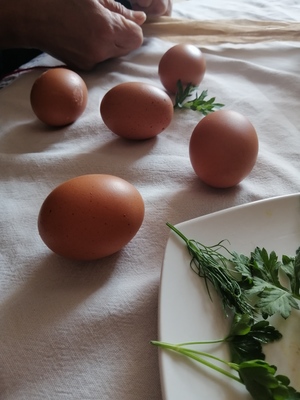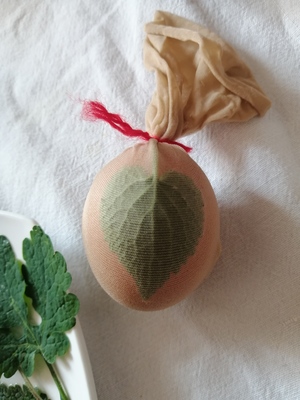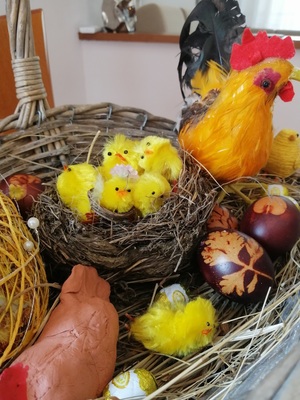EASTER IN SLOVENIA AND BRDA
Easter is the oldest and the most important Christian holiday, celebrating the resurrection of Jesus from the dead. It doesn't have a particular date and it's somewhere between the 22nd March and 25th April. Most Christians refer to the week before Easter as the Holy week. Many Easter customs were taken from the pagan religion. Some old Slovenian names for Easter were vuzem (in Bela krajina), vazem (in Istria), vezom (in Kostelsko), vüzem (in Prekmurje).
A very important day in the Easter time is Palm Sunday. On this day, people bring flowers to church. Two of the most important Easter dishes are meat and bread. Sweet bread is also a very important Easter dish in Western Slovenia. All Slovenian Easter dishes present many religious symbols. Every year in Prekmurje, there’s a big Easter egg exhibition.
In the past (and partly still today), on Ash Wednesday, people “buried” the so called Pust (a stuffed man that represents the carnival) and started the Fast that lasted until the beginning of Easter. The Fast is the time of abstinence and mourning. People had to strictly follow the Fast rules. The Ash Wednesday, every Friday during the Fast and the Holy Saturday were meat-free. The Fast time was also the time when children had to do good works and refuse any delights. Sunday before Easter is called Palm Sunday because on that day Christians bring olive branches to church for the priest to bless them. During this time, the villages with larger olive groves made a lot of money with selling olive twigs. They put the blessed twigs on the cross that was hanging in the kitchen. They let a few of the blessed twigs to dry and then burned them and blessed their ashes. The Palm Sunday was followed by the Holy Week and the most strict Fast. Some people only drank water since the Christ’s death until his resurrection. On the Holy Saturday, when the festive bell ringing started, the Fast was officially over.
Easter is besides Christmas the most important Christian holiday, but as an interesting fact it doesn’t have a permanent date. It’s held on the first Sunday after the first spring full moon. People prepared to celebrate Easter with thorough cleaning of all the living quarters, of themselves and also of the animals. Children got new clothes, shoes and socks that had to last for the whole year. Housewives baked a lot of Easter goods such as walnut cakes (in Slovenian it’s called “orehova potica”), “kuglof” (a type of leavened marble cake) and a sweet loaf of bread to be brought to church and be blessed). They used the same type of dough to bake a pastry in the shape of a pigeon or a bunny for the children. They also took those to church to be blessed.
One of the old habits was also egg colouring and to colour the eggs people in the past used onion leaves, walnut leaves, forsythia blossoms, coffee grounds…
The Saturday afternoon was very exciting for children because they brought all the Easter goods to church to be blessed. The blessed food had to be treated and eaten respectfully.
On Easter day people used to eat a piece of blessed bread on their empty stomachs, right after they kissed it, but they had to be careful not to drop any bread crumbs on the floor. Easter breakfast was really rich. Each of the family members got a piece of ham,a few fuje (special bread dough with raisins boiled in salty water that had been previously used to cook the ham), a boiled egg and grated horseradish on their plate. Another traditional easter dish was a soup called žolca (a sort of brawn soup), which was served for at the afternoon snack or for lunch, where it was served as an appetizer.
After such a heavy breakfast, all family gathered together to go to mass. A lot of people also roasted a billy goat that they donated to the priest.
On Easter afternoon, family and friends gathered, and competed in fencing eggs. In some families they used to hide eggs and then try to find them and the person who found most of the eggs won.
For every Christian, the Easter confession was an obligation where the priest gave holy cards to the confessors. The priest got some eggs, sometimes even sausages, for every holy card. This habit was abandoned in the time between both wars.
Bits and bobs:
One of the oldest Easter dishes are eggs.In Slovenia, they are called: pisanka, pisanka, pirhi and rumenke.
The eggs are painted and decorated.
In the Easter season, there are many games and competitions with pirhi.
A very old is a game is called hatching and knocking.
Each region has its own customs.
Pirhi, horseradish, ham and eggs musn't be blessed on Saturday.
Easter rumble meant the repulsion of evil forces. In the western Slovenia, people got ready for Easter by firing bonfires on Easter Saturday. Easter Monday was a youth holiday. The youth were dressed in the most beautiful clothes. They attended dances, festivities and inns, and played various humorous easter egg games.
The dishes that symbolize Easter are:
-red easter eggs (symbolize the drop of Christ’s blood)
-horse radish (the symbol of the nail, with which Christ was crucified)
-the cake potica (symbolizes Christ's thorn crown)
-eggs (a symbol of spring, announcing a new life)
-bread (represents life)
-flowers (symbol of Jesus' resurrection from the dead)
Examples of traditional Easter egg decoration:



Our 9-graders also put together relevant information in Slovenian for our younger students:
https://docs.google.com/document/d/1iKp0v22fjSACjB_Z1h0UfRfp52FOjObZiqmRzELf2ng/edit?usp=sharing
EASTER TRADITIONS IN POLAND (SILESIA)
In this video you can find the most important information about Easter traditions